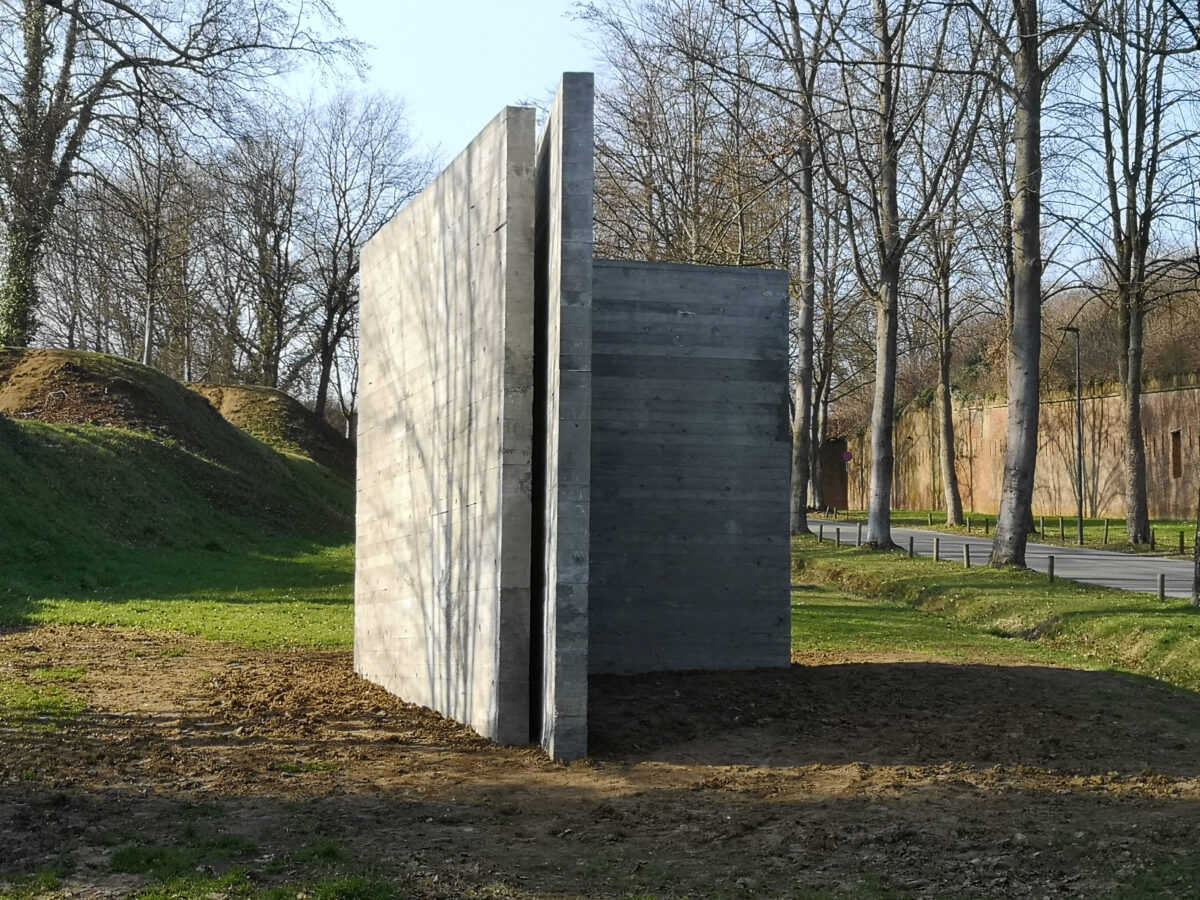Along the side of Leuvenstraat, as soon as one approaches the driveway of the former military domain ‘De Citadel’, one is confronted with an impressive work of art by Henk Delabie. His Blind Spot Diest, commissioned by the city, rises straight up against the remains of the 19th century brick city wall, a segment of the Leuven city gate that used to be part of the former city walls. The stately concrete creation questions its contextual surroundings with which it connects to become a unique landmark.
Not in the least as a power-distributing counterweight, as a “counter-post” to the succession of vertical and vista-defining embrasures in the city wall, behind which is situated a succession of casemates. More popularly known, however, as the legendary “white corridors”.
Like a concrete sentinel – taking root on the edge of a dry moat buried under many layers of mortar – overseeing the past of our future: a piece of land that is allowed to follow its own course again. A minuscule patch of dirt where natural processes are once again given some space: a newly realised slice of natural culture. Only the furtive glance of a casual passer-by, an alert observer or a judicious observer of newfangled phenomena can peer sideways through the narrow but inviting gaps, to gain a somewhat explanatory insight into the secrets that may be contained within.

The remarkable walls of Henk Delabie do not claim, but give back unconditionally. Space-delineating walls that literally safeguard an unexpectedly enclosed triangular surface from outside interference. From any kind of human activity. And as such, the construction allows itself to be read as a critical reflection on spatial duality, inspired by solid artistic craftsmanship. An architectural composition in which an initially simple, playful visual language ultimately evokes an indefinable sense of space-piercing alienation.
A surprising spectacle with almost insignificant viewing slits, that wants to make a positive statement to compensate for a historically too one-sided concept of spatial planning.An appealing and dialogue between living and non-living matter, about who gets to appropriate what today and about how we, as unbiased bystanders, still too often, too anxiously, cling to often outdated representations.Concrete rising from the ground, backed by a series of earthen ‘molehills’ (the final remains of former artillery emplacements) in the lee of the trees, that clearly draws the vast surroundings into a striking mood-setting story.

Implicitly, both site-specific installations, the brick wall and its concrete counterpart on the other side – whose more than five metre-long wall runs roughly parallel lentghtwise to the rampart – undeniably refer to phenomena such as demarcation, limitation and connection. Moreover, they fundamentally question such profound concepts as private space, public space and inner space. In the end, these points of reference position themselves in relation to each other like a mutual field of tension between tradition and progressiveness. The voluntary or involuntary recognition of this inflected hint forces the observer to meaningfully engage with their unfathomable mystical and space-determining character.
Just as wonder is often created by visually describing, at a moment deemed appropriate, that which is factually given as an unseen possibility, here too the artist rearranges the playable surrounding space. He describes, as it were, new standards of controlling, occupying and marking a landscape. He reshapes our territorial understandings and behaviours with regard to the environmental building blocks in which something or someone acquires meaning. From the full realisation that the additional factuality of the in-between spaces that have been saved both inside and all around, could conceivably, from here and now, also be a guideline for a final daring to let go of fragments of space, and the impact on both people and the environment this is inextricably linked with.
Blind Spot Diest is made of light grey concrete wall elements, cast on site. Together, they form a contemporary architectural focal point that invites continuous encounters and exchanges in a striking location that is riddled with its own history.
Benny Madalijns,
PhD in Archaeology and Arts Sciences
Free University of Brussels
